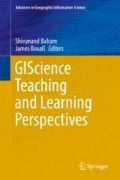Abstract
Scientific research skills can be a valuable asset for undergraduate students pursuing spatial modeling and geographic information science courses. These skills provide students with a systematic means to think critically, solve complex geospatial problems, and contribute in meaningful ways to the scientific knowledge creation and dissemination process. In this study, targeted changes are described for an upper-division undergraduate spatial modeling course where students were guided through all the stages of the scientific research process. Students then developed geospatial solutions to real-world problems and communicated their results at a real scientific conference. Based on anonymous student feedback, the experience was perceived to be rewarding and the research skills gained to be a lifelong asset.
Access this chapter
Tax calculation will be finalised at checkout
Purchases are for personal use only
References
Arribas-Bel, D., & Reades, J. (2018). Geography and computers: Past, present, and future. Geography Compass, 12(10), e12403.
Bowlick, F. J., Goldberg, D. W., & Bednarz, S. W. (2017). Computer science and programming courses in Geography Departments in the United States. The Professional Geographer, 69(1), 138–150.
Chen, X. M. (1998). Integrating GIS education with training: A project-oriented approach. Journal of Geography, 97(6), 261–268.
Clark Labs. (2015). TerrSet geospatial monitoring and modeling software. Worcester, MA: https://clarklabs.org/terrset/
Delahunty, T., Lewis-Gonzales, S., Phelps, J., Sawicki, B., Roberts, C., & Carpenter, P. (2012). Land cover change and remote sensing in the classroom: An exercise to study urban growth. Journal of Geography, 111(3), 113–122.
Ebenezer, J., Kaya, O. N., & Ebenezer, D. L. (2010). Engaging students in environmental research projects: Perceptions of fluency with innovative technologies and levels of scientific inquiry abilities. Journal of Research in Science Teaching, 48(1), 94–116.
ESRI USA. (2015). ArcGIS Desktop, release 10.4. Redlands, CA: http://desktop.arcgis.com/en/
Grant, M. C., Fisher, D., & Lapp, D. (2013). Teaching students to think like scientists: Strategies aligned with common core and next generation science standards. Bloomington: Solution Tree.
Kemp, K. K., Goodchild, M. F., & Dodson, R. F. (1992). Teaching GIS in geography. The Professional Geographer, 44(2), 181–191.
Lopatto, D. (2007). Undergraduate research experiences support science career decisions and active learning. CBE Life Sciences Education, 6(4), 297–306.
McMillan, C., Loads, D., & McQueen, H. A. (2018). From students to scientists: The impact of interactive engagement in lectures. New Directions in the Teaching of Physical Sciences, 13(1). https://doi.org/10.29311/ndtps.v0i13.2425.
Seymour, E., Hunter, A.-B., Laursen, S. L., & DeAntoni, T. (2004). Establishing the benefits of research experiences for undergraduates in the sciences: First findings from a three-year study. Science Education, 88(4), 493–534.
Taraban, R., & Blanton, R. L. (Eds.). (2008). Creating effective undergraduate research programs in science: Transformation from student to scientist. New York: Teachers College Press.
Trosset, C., Lopatto, D., & Elgin, S. (2008). Implementation and assessment of course-embedded undergraduate experience: Some explorations. In R. Taraban & R. L. Blanton (Eds.), Creating effective undergraduate research programs in science: The transformation from student to scientist (p. 256). New York: Teachers College Press.
Acknowledgments
This project was fully funded by a Simon Fraser University (SFU) Teaching and Learning Development Grant (TLDG) awarded to the first author. The authors thank Angela McLean and Laura D’Amico from the Institute for the Study of Teaching and Learning in the Disciplines (ISTLD), SFU, for their valuable guidance during the project development and implementation. Special thanks to Dr. Brent Hall of Esri Canada for making possible the students’ attendance and poster presentations at the 2015 Esri User conference in Vancouver, Canada.
Author information
Authors and Affiliations
Corresponding author
Editor information
Editors and Affiliations
Rights and permissions
Copyright information
© 2019 Springer Nature Switzerland AG
About this chapter
Cite this chapter
Dragićević, S., Anderson, T. (2019). Enabling Scientific Research Skills in Undergraduate Students During a Spatial Modeling Course. In: Balram, S., Boxall, J. (eds) GIScience Teaching and Learning Perspectives. Advances in Geographic Information Science. Springer, Cham. https://doi.org/10.1007/978-3-030-06058-9_3
Download citation
DOI: https://doi.org/10.1007/978-3-030-06058-9_3
Published:
Publisher Name: Springer, Cham
Print ISBN: 978-3-030-06057-2
Online ISBN: 978-3-030-06058-9
eBook Packages: Earth and Environmental ScienceEarth and Environmental Science (R0)

